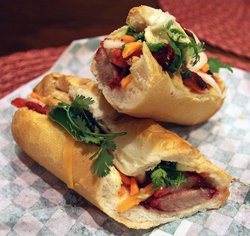Cookbook:Sandwiches

Cookbook | Recipes | Ingredients | Equipment | Techniques | Cookbook Disambiguation Pages
Sandwiches are a food item consisting of bread filled or topped with other components. According to legend, they are attributed to John Montagu, the Earl of Sandwich, and they are designed to be eaten with the hands. There are various slang terms for a sandwich, such as butty and sarnie. Note that sandwiches are distinct from wraps, which consist of a thin flatbread rolled around the filling.
Characteristics
[edit | edit source]Bread
[edit | edit source]A wide variety of breads can be used to make a sandwich, including soft pullman loaves, crusty breads, pumpernickel, rye bread, flatbreads, rolls, and more. The choice of bread will depend on the filling and the presentation. In general, the bread has to be thick enough to support the entire sandwich and its filling, but not so thick that it makes the sandwich overly-dry and hard to eat. Delicate sandwiches tend to require finer, thinner bread that holds together well. Robust sandwiches can handle thicker, crusty bread. The bread may or may not be toasted, depending on the sandwich and the cook's preferences. If toasting the bread, it should be done as close to serving as possible.
Filling
[edit | edit source]Sandwiches may be filled with almost anything, but some options are more common. Some of these include bacon, turkey, alfalfa sprouts, spinach, shawarma, pastrami, corned beef, pickles, tongue, fried clams, fried fish, ham, olives, cheese, tuna, deli meats, lettuce, tomatoes, and onions.
In addition to the primary filling(s), sandwiches often have some variety of spread that contributes flavor, moisture, and cohesion. These include butter, mayonnaise, mustard, relish, and more. Some sandwiches consist entirely of spreads, such as peanut butter, honey, or jam.
Serving
[edit | edit source]Sandwiches can take a variety of shapes and be served in different ways. Closed sandwiches, which are the most common variety, have bread on the top and bottom—the filling is "sandwiched" between the two pieces. Open-faced sandwiches are less common and have only one slice of bread on the bottom, with the filling sitting on top. Some varieties of sandwich have the crust trimmed off to make them more delicate, and larger sandwiches are usually halved or quartered for ease of of consumption. Finger sandwiches take this even further—they are cut into small pieces, meant to be eaten in one or two bites as snacks or appetizers. At a sandwich buffet, cocktail sticks are often stuck through the sandwiches, making them easier to lift by partygoers.
Common varieties
[edit | edit source]- Reuben: Hearty, hot sandwich containing corned beef, cheese, and sauerkraut on pumpernickel bread
- Club sandwich: Contains chicken, mayonnaise, lettuce, tomato, and bacon
- Sub/hoagie/grinder/Hero: Long, thin sandwich containing a range of savory fillings
- Tea sandwich: Small sandwich made with fine, delicate bread; fillings commonly include salmon, cucumber, and other light ingredients
- Croque monsieur: Hot, grilled sandwich containing ham, cheese, and mustard
- Croque madame: Similar to a croque monsieur, but with an egg added
- Panini: Hot, grilled sandwich of Italian origin, made in a panini press
- Banh mi: Vietnamese sandwich consisting of French bread and various savory fillings
- Peanut butter and jelly (PB&J): Simple sandwich filled with peanut butter and jelly or jam
As a verb
[edit | edit source]The term sandwich has recently evolved to become a verb—'sandwiching' something means to insert/place that thing between two outer things. See, for example, sandwich cookies.
Gallery
[edit | edit source]-
Reuben sandwich
-
Sub(marine) sandwich
-
Banh mi
-
Peanut butter and jelly sandwich
-
Panini sandwich
-
Finger sandwiches
-
Grilled cheese sandwich







